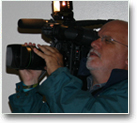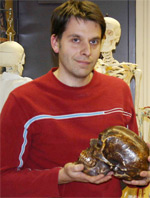 Are We Related to Neanderthals?FOR IMMEDIATE RELEASE According to archaeologist Dr. Eugène Morin, the long-held view that 35,000 to 40,000 years ago Neanderthals died out and were replaced by migrant homo sapiens in western Europe is not as convincing as once thought. Monday, January 7, 2008, Peterborough
In his study, Prof. Morin suggests that instead of declining to extinction, Neanderthal anatomical characteristics were largely attenuated during an episode of significant population decline caused by a climatic deterioration. “This cold snap reduced the diversity of animals hunted by the Neanderthals and affected their diet,” said Prof. Morin, who specializes in faunal archaeology. His theory is based on animal bones recovered at Saint-Césaire, an archaeological site located in western France that he has been analyzing for the past seven years. Based on this evidence, Prof. Morin argues that large herbivores such as bison and horse decreased in numbers, whereas reindeer, a cold-adapted species that fluctuate widely in abundance, became the dominant herbivore species over the landscape.
Though Prof. Morin agrees that some humans might have migrated to Europe during that period, he does not think that it happened to “the large scale implied by many scholars.” Rather he believes that rapid genetic changes in the evolution of local populations prevailed over large-scale migration phenomena during the transition between the Middle to the Upper Paleolithic. -30- For further information, please contact Professor Eugène Morin, anthropology department at (705) 748-1011, ext. 7682. |

































 Professor Morin’s latest study positing that modern humans may indeed be related to early Neanderthals will appear next week in the highly esteemed Proceedings of National Academy of Sciences.
Professor Morin’s latest study positing that modern humans may indeed be related to early Neanderthals will appear next week in the highly esteemed Proceedings of National Academy of Sciences. “Given this climatic deterioration the environment could not have supported a population increase due to a modern human expansion into Europe, as argued by the promoters of the Neanderthal replacement model,” he explained. “Instead, Neanderthals experienced several episodes of population bottlenecks, yet succeeded in maintaining genetic ties with other neighbouring populations, including anatomically modern humans from Africa.” Over the long term, Neanderthals adapted to this harsher climate by expanding their social networks, a process that allowed the diffusion of "modern traits" into the Neanderthal gene pool. These findings provide support to the hypothesis that Neanderthals contributed, although minimally due to the smallness of their population, to the emergence of modern humans.
“Given this climatic deterioration the environment could not have supported a population increase due to a modern human expansion into Europe, as argued by the promoters of the Neanderthal replacement model,” he explained. “Instead, Neanderthals experienced several episodes of population bottlenecks, yet succeeded in maintaining genetic ties with other neighbouring populations, including anatomically modern humans from Africa.” Over the long term, Neanderthals adapted to this harsher climate by expanding their social networks, a process that allowed the diffusion of "modern traits" into the Neanderthal gene pool. These findings provide support to the hypothesis that Neanderthals contributed, although minimally due to the smallness of their population, to the emergence of modern humans.